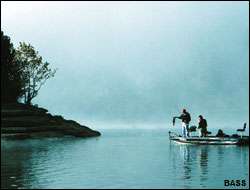
Ask any professional about crankbait technique and eventually, somewhere in the conversation, he will mention David Fritts. To them, and to anyone who is a follower of the BASS circuit, Fritts is the undisputed master of the technique.
While there are many reasons for his dominance in crankbaiting, one of the most crucial factors is in his uncompromising attention to detail. Instead of being satisfied with choosing a productive lure, he wants to choose the most productive lure. The same applies in his approach to structure fishing.
For most fishermen, simply finding an area that holds fish is the goal. Once achieved, the refinement process doesn't go much further. Not with Mr. Fritts. To him, every piece of structure — points, flats, ridges, humps, etc. — offers one spot where most of the fish come to feed. Some call it the "sweet spot," but Fritts prefers to label these often small spots within spots, "ambush points."
Since every structure situation is as unique as a fingerprint, there is no set formula for finding the ambush point. There are, however, some useful guidelines.
First, an ambush point will most likely involve some sort of irregularity on the structure. This can be any number of things from a high spot, abrupt depth change, isolated cover or rock, anything that will collect both bait and bass. Unfortunately, these ambush points are not usually obvious, even with the help of sonar. In most cases, they're a subtle blend of things that don't immediately say, "Fish here."
Sonar can get you close though, offers Fritts, since ambush points are usually positioned where the shallowest water on the structure meets the deepest water. Find that transition, and somewhere in the immediate vicinity will be the best place on the entire structure to present your crankbait.
Second, while the general location of an ambush point can be discovered with sonar, the exact position can only be determined by swimming a crankbait through it. As a result, a fisherman must know precisely how deep a particular lure will dive and how fast it reaches that maximum depth range.
By understanding that every crankbait follows a downward curving path like a pendulum, an angler can judge how far to cast beyond a target to make this arc intersect precisely with the ambush point.
In most instances, the object is to have the crankbait barely tick the structure as it wobbles past. It's a sometimes tricky maneuver to learn, since the lure is only at that depth for a brief period during the retrieve, and the ambush point may only measure in yards, if not feet. Of course, the payoff is a level of consistency in generating strikes that most casual crankbaiters might find astonishing.
Since many of these structure areas are located offshore, it is crucial that an angler know precisely where to position the boat to make productive casts. Although Fritts prefers not to use marker buoys, it's really a matter of personal preference how someone keeps track of his/her position — whether that means triangulating with shoreline features or dropping buoys.
Third, the process doesn't end with the successful discovery of an ambush point and making a cast that places the lure in this all-important strike zone. At this point, Fritts begins exploring different casting angles, trying to find the optimum path. While maximizing the potential of any spot is at the heart of Fritts' "ambush point" philosophy, there is a more basic reason, one that directly applies to weekend fishermen as much as professionals.
"By knowing the ambush points, I don't have to spend time going all the way around a point or all the way down a flat. I know exactly where to go and where to throw my bait. And, I know if the fish are biting right now — or not."




